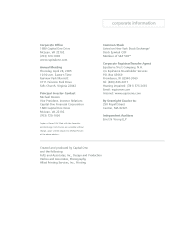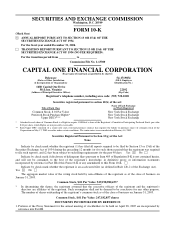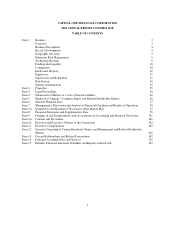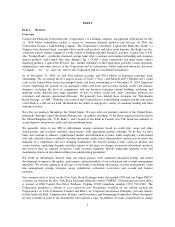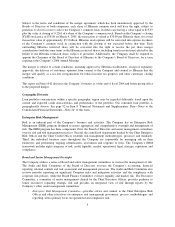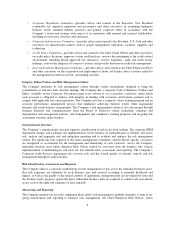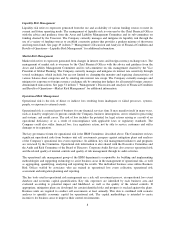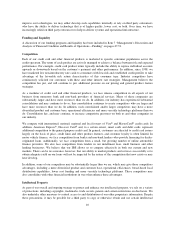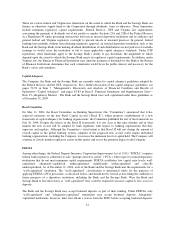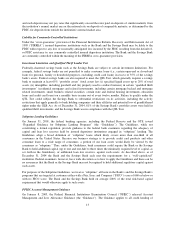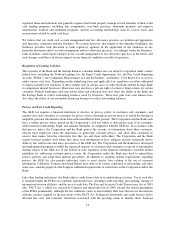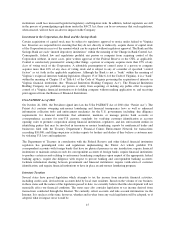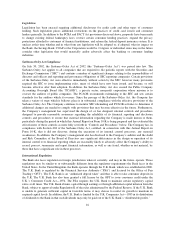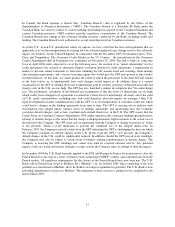Capital One 2004 Annual Report Download - page 30
Download and view the complete annual report
Please find page 30 of the 2004 Capital One annual report below. You can navigate through the pages in the report by either clicking on the pages listed below, or by using the keyword search tool below to find specific information within the annual report.management committees and the Board and its committees. Additionally, Corporate Audit Services performs
separate evaluations of the system of internal control and risk management capability. Corporate Audit Services
reports on the scope and results of its work to the Audit and Risk Committee of the Board of Directors.
Credit Risk Management
Successful management of credit risk, the risk that borrowers may default on their financial obligations to the
Company, is important to the Company’s success. There are four primary sources of credit risk: (1) changing
economic conditions, which affect consumers’ ability to pay; (2) changing competitive environment, which
affects consumer debt loads and borrowing patterns; (3) the Company’s underwriting strategies and standards,
which drive the selection of customers and the terms offered; and (4) the quality of the Company’s internal
controls, which establish a process to test that underwriting conforms to Company standards and identify credit
quality issues so the Company can act upon them a timely manner. The Company is focused on managing each
of these sources of credit risk.
The Company’s Chief Credit Officer is charged with overall management of credit risk. The goal is to provide
strong central oversight of credit policy and programs while maintaining the ability of operating units to respond
flexibly to changing market and competitive conditions. The Company’s Chief Credit Officer manages a
corporate Credit Risk Management staff and chairs the Credit Policy Committee, a committee of senior
management. The Credit Policy Committee oversees and approves corporate credit policy and credit
performance. Its members include the Chief Credit Officer, the Chief Enterprise Risk Officer and the Presidents
of the Company’s three operating divisions. The Chief Credit Officer and his staff review and approve all large
scale new credit programs. Smaller credit programs are approved by Senior Credit Officers appointed by the
Credit Policy Committee and supervised by the Chief Credit Officer and his staff. All credit programs must also
be approved by the appropriate operating executives. These organizational structures are designed so that each of
the Company’s business units applies standardized practices in measuring and managing credit risk, and that all
relevant factors, such as credit outlook, profitability, and the competitive, economic, and regulatory environment,
are considered in making credit decisions.
The Board of Directors has established policies that limit the level and composition of risk in the total lending
portfolio. The Company’s Credit Policy Committee has established policies that govern credit administration and
individual lending decisions. The centralized Credit Risk Management group monitors overall composition and
quality of the credit portfolio.
The Company’s credit risk profile is managed to maintain resilience to factors outside of the Company’s control,
strong risk-adjusted returns, and increased diversification.
The Company’s guiding principles, strengthened central governance, and Board-directed credit risk tolerances
are designed to keep senior executives well-informed of credit trends so they can make appropriate credit and
business decisions for the Company. The Company enhances/preserves day-to-day market responsiveness and
flexibility by empowering its business line managers to develop credit strategies and programs aligned with the
Company’s credit risk policies and objective of long-term business profitability. The credit program development
process considers the evolving needs of the target market, the competitive environment, and the economic
outlook. Senior Credit Officers, who are appointed by the Credit Policy Committee, oversee all credit program
development.
Most of the Company’s credit strategies rely heavily on the use of sophisticated proprietary scoring models.
These models consider many variables, including credit scores developed by nationally recognized scoring firms.
The models are validated, monitored and maintained in accordance with detailed policies and procedures to help
maintain their continued validity. The Company’s Chief Scoring Officer, a member of the Chief Credit Officer’s
staff, oversees the development and implementation of key statistical models.
7




